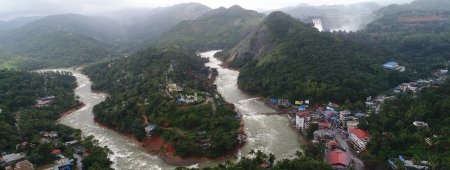Planning for the Worst: Could Anything Have Helped in Haiti?

Last week's destruction in Haiti resulted from a huge earthquake near a susceptible population. The increased number of residents living in hazardous places around the world is the motivation behind a unique graduate program at Michigan Technological University.
“We try to reduce vulnerability,” says Bill Rose, professor of petrology and director of Michigan Tech’s Peace Corps Master’s International Program (PCMI) in Natural Hazards Mitigation. “We can tell people what may happen, and we can help save lives; we increase awareness and the ability for people to save themselves.”
The three-year master’s degree program includes a two-year field experience abroad. There, communication is key.
Rose stresses the importance of talking to people in local schools and government agencies before natural disasters occur. In addition to earthquakes, student volunteers in the program address volcanoes, floods, landslides and droughts.
They can help by aiding in “community-level natural hazard education,” according to John Lyons, currently a PhD candidate at Michigan Tech who participated in the PCMI program in Guatemala. Although better known for its volcanic hazards, Guatemala is home to numerous earthquakes, says Lyons.
“They had no education or planning,” Lyons recalls. “So we went through the basics with the teachers first, teaching them how earthquakes occur and what to do in the event of an earthquake. Then we taught their students about earthquakes and ran the schools’ first earthquake drills.”
Residents may also need to be taught what might seem obvious, Rose says. They can be taught that a river valley can become dangerous, so they should get out of the valley into the hills instead of moving downstream. Or the not-so-obvious: in the case of a tsunami, if a wave goes out and exposes bare ground, head for the hills too.
One major problem is that there are so many more pressing issues in most countries, Lyons says, and earthquake or volcano education can be pushed aside. That is especially true in Haiti, Rose adds, where the people clamor for clean water and sanitation, better housing and healthcare.
“Hunger takes precedence,” Lyons says.
But volunteers can teach “simple things” that students can do on their own, Lyons adds, such as “getting under desks or in doorframes instead of running down the hallway or pushing toward exits.”
Lyons believes that the Peace Corps volunteers could also learn first aid and be trained as first responders.
“We could go into the disaster scene and give advanced first aid,” he says, “or help with triage, organize searches and potentially help people get out of collapsed buildings.”
Volunteers could take on the role of disaster response workers, in addition to their normal Peace Corps assignments. Previous talk on training and certification of volunteers as first responders has been cut short because of funding, Lyons says.
“As a volunteer, there is a difference between identifying a problem or hazard and being able to address it, because the scale is so huge,” he adds. “That’s why it’s important for all volunteers, whether they are from forestry or business or humanities, to get involved in some sort of hazard awareness and disaster preparedness.”
Lyons spoke from experience about one common obstacle. Smaller earthquakes can occur more often, and the locals can become desensitized to them, as was the case in Guatemala when he was there--until they were hit with a 6.1 quake, albeit far from the epicenter.
“We were heading for the doorframes,” he says, “and we were wondering if it would get bad.”
It’s hard to imagine any good coming out of anything as bad as the earthquake in Haiti. But Rose hopes it might
“The disaster might lead to more earthquake engineering,” says Rose, “where structures can be rebuilt to withstand quakes for another 100 years or more, and even if they receive some damage, they won’t collapse like they did.”
Rose says it is especially necessary to build better hospitals, schools and other places where people congregate. “It might cost a bit more, but it will be worth it.”
Rose knows his subject. He’s been involved in hazard communications for many years in Guatemala and elsewhere. And, although the Michigan Tech Peace Corps program has focused on Latin America, they want to expand into Indonesia, too, he says.
And he sees another potential outcome.
“The increase in populations in hazardous areas has changed the habits of geologists,” he says. “We used to go out in the woods alone and come back weeks or years later with a load of rocks and a map, then stay in town just long enough to find the next spot in the woods that needed attention. Now we have to communicate with people long enough to be sure they understand. We call it social geology. We are much more connected, and the world needs it. It feels good.”
He says the world also needs better communication about other earth science issues, such as global climate change.
“We are the ones who really study how the earth works,” he says. “But we have been keeping it a secret.”
Now, that is changing, and this ongoing global public education speaks volumes about the Peace Corps and Michigan Tech, as the students and faculty communicate to help save lives.
Michigan Technological University is an R1 public research university founded in 1885 in Houghton, and is home to nearly 7,500 students from more than 60 countries around the world. Consistently ranked among the best universities in the country for return on investment, Michigan's flagship technological university offers more than 120 undergraduate and graduate degree programs in science and technology, engineering, computing, forestry, business, health professions, humanities, mathematics, social sciences, and the arts. The rural campus is situated just miles from Lake Superior in Michigan's Upper Peninsula, offering year-round opportunities for outdoor adventure.




Comments